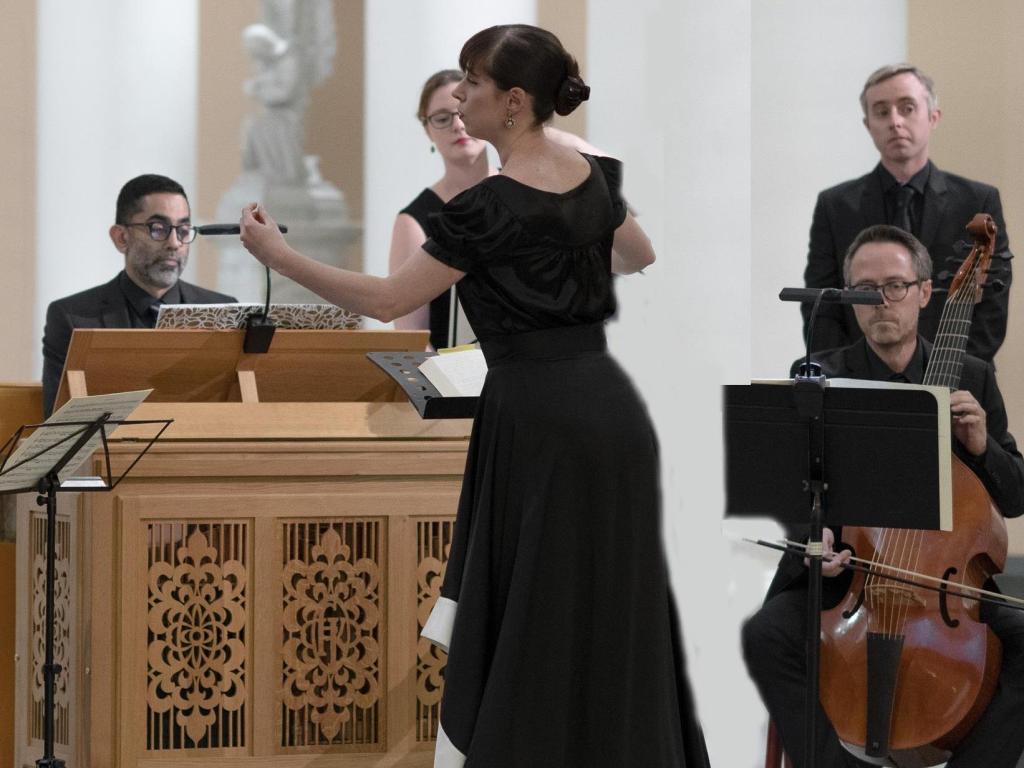Neal Peres Da Costa, Madeleine Easton and Daniel Yeadon play A Musical Offering. Supplied.
Firebrand Australian violinist Madeleine Easton is the artistic director of the new, well-patronised and well-organised Bach Akademie Australia. With many years’ experience working with the finest period ensembles in the world and most imaginative conductors, her vision is ambitious: to form an Australian Baroque period-instrument ensemble comparable to any in the world. Based on my experience hearing the BAA perform for the first time on Friday night there is evidence that in time she will succeed. Since its recent establishment, this smart youthful ensemble already has an impressive governance and strong body of friends and patrons. The ensemble presented music making of a rare brilliance performing Johann Sebastian Bach’s late-composed Musical Offering (Musikalisches Opfer or Das Musikalische Opfer, BWV 1070).
At this late stage in his career, Bach seemed to retreat more and more from the practical necessities of sacred cantata writing at St Thomas Leipzig in favour of enjoying the pleasures of musical diversions that may never have been intended for performance such as the B minor Mass and Die Kunst der Fuge (The Art of Fugue), that he did not complete. A Musical Offering came about as a challenge from Frederick II (‘the Great’) of Prussia, a musically gifted monarch who, when Bach was on a visit in 1747 to his palace in Potsdam, provided the composer with a melody for compositional development. Bach responded immediately on the palace’s smart new fortepianos but became frustrated with his initial efforts. Two months after his return to Leipzig Bach dispatched a score of A Musical Offering to the King. The most remarkable music was a Ricercar in six parts that was the reply to the King’s ambitious challenge. A fugue in six parts extended Bach’s compositional gifts to the very limit and it is an exhilarating experience when performed.
On a chilly Friday night, Sydney’s St Mary’s Cathedral Crypt was not an easy venue to find with minimal signage, almost no lighting, just one small gate open and one door to enter; several patrons were wandering aimlessly in darkness when I arrived. A team of dedicated volunteers within, however, were managing the concert and seating a capacity audience. The Crypt is a long room with a five-metre-tall, cement-vaulted ceiling and an attractive terrazzo floor. The ensemble was placed halfway down one side, with chairs gathered around its performing space. The acoustic for this contrapuntal repertoire proved to be ideal: resonant yet clear.

The Bach Akademie Australia. Supplied.
After some welcoming remarks and an announcement re-ordering the program, the recital commenced. The opening Ricercar a 3 was elegantly understated with expressive articulation in Neal Peres Da Costa’s performance on an Andrew Garlick copy of an 18th-century French double manual after Goujon. It is a very tall order to open with such transparent material and if this performance was not note-perfect, it amply provided a foretaste of the refinements to come. Ten canons followed that were all introduced in forensic detail by members of the ensemble, every theological riddle and compositional puzzle unveiled: the reversal, retrograde, mirror imaging, augmentation and contrary motion etc of the Thema Regium. Some of the canons were so brief, there appeared to be as much explication as performance and the running commentary could have been curtailed if not deleted altogether.
This could be overlooked, however, by such richly rewarding music being performed with perfect instrumental balance, as much from the composer’s genius as the performers’ accomplishment. Occasionally I looked around me to see an audience in intense and deeply satisfied concentration, the Thema Regium dancing before their minds in ever-increasing elaboration. One memorable highlight for me was the double-dotted French grace of the Canon 4, a 2 per augmentationem, contrario motu for violin and continuo.
The work ended with the famous Ricercar a 6, a masterpiece of succinct musical tapestry that left the audience mesmerised. However, the concluding Sonata sopr’il Soggetto Real a Travera, Violino e Continuo lacked something of the polish of the earlier pieces.
This rare performance of the Bach Akademie Australia was characterised by intense attention to detail, particularly in the subtle phrasing, timbre and texture of the strings, the elegance, true tuning and elegant voicing of Oberg’s flute and Neal Peres Da Costa’s harpsichord playing. Here is an excellent and ambitious new ensemble, each of its musicians expertly trained by the best in the world and all carrying significant international experience, creating a standard of Baroque performance rarely heard in Australia.
Rating: 4 ½ stars ★★★★☆
A Musical Offering
Presented by the Bach Akademie Australia
Neal Peres Da Costa, harpsichord
Daniel Yeadon, gamba
Mikaela Oberg, flute
Madeleine Easton, violin
Rafael Font-Viera, violin
27 July, 2018
St Mary’s Cathedral Crypt, Sydney





